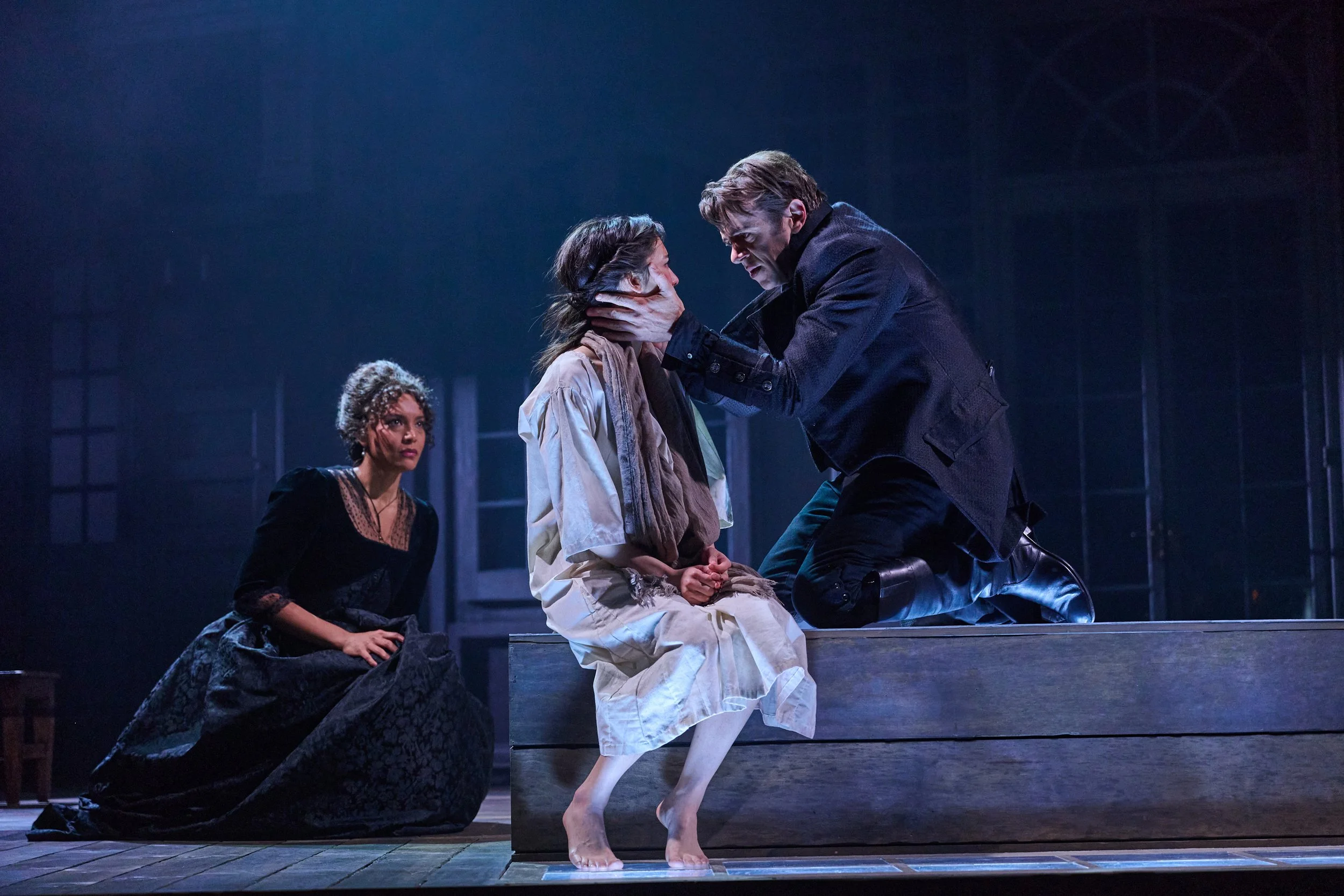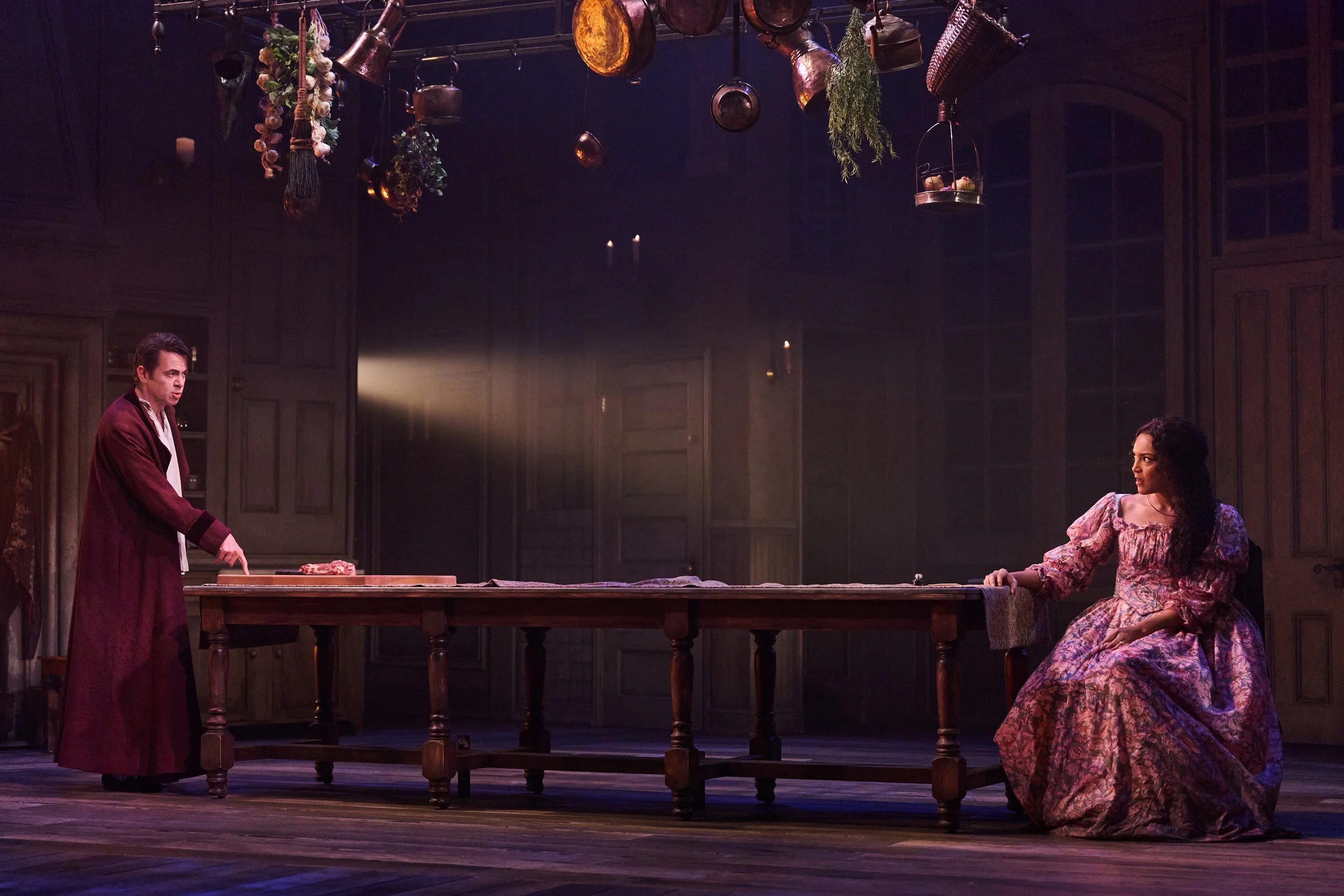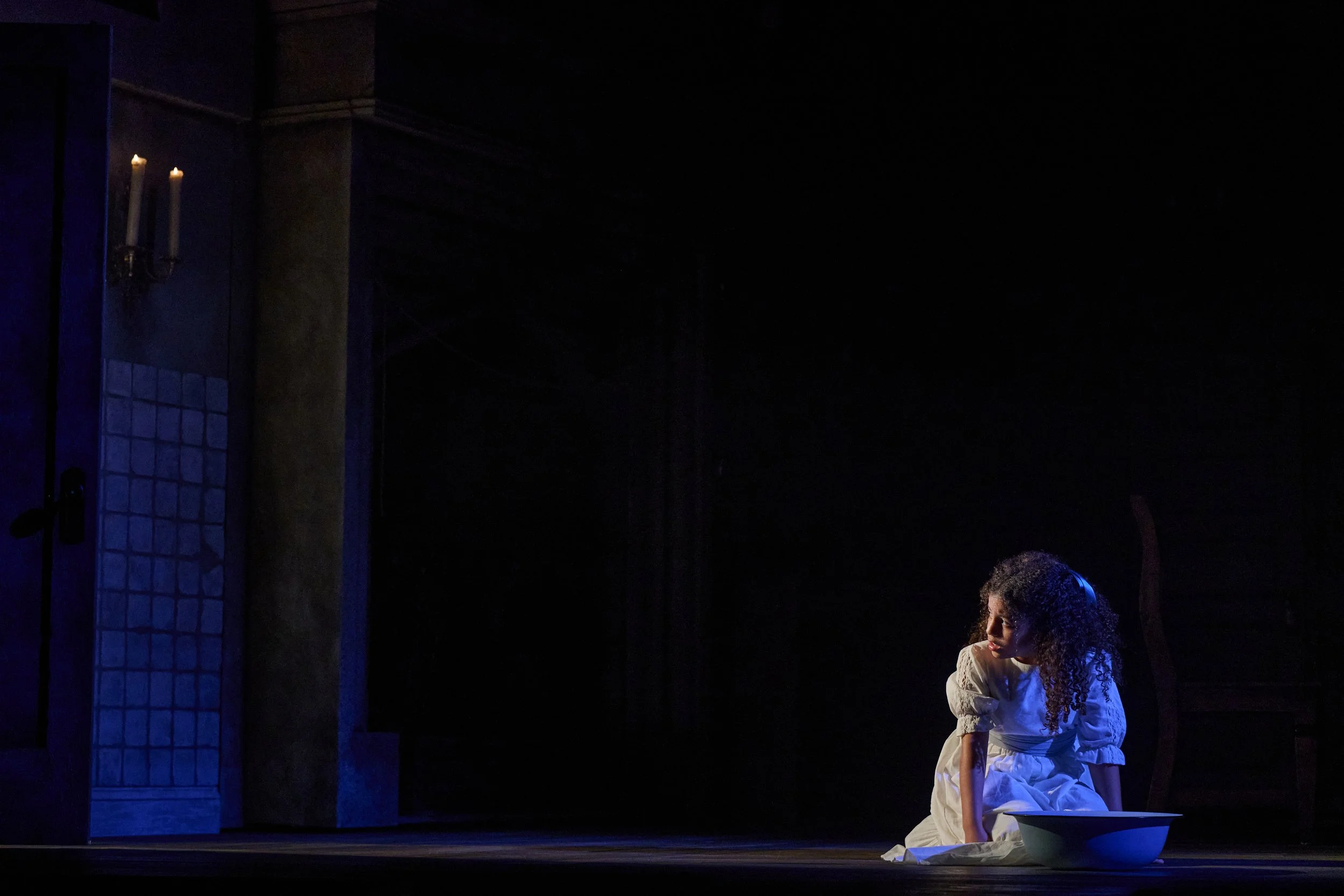An ambiguous, thrilling adaptation of Mary Shelley’s classic novel
[Rebecca S’manga Frank, Anna Takayo, and Nick Westrate in Frankenstein at Shakespeare Theatre Company. Photo by DJ Corey Photography.]
A review of Frankenstein at The Shakespeare Theatre
by Norah Vawter
Emily Burns’s adaptation of Mary Shelley’s Frankenstein is the kind of play that makes me an active participant in the drama and sits with me after the curtain call, getting more and more interesting as I mull it over. Written and directed by Burns, this world premiere was commissioned by The Shakespeare Theatre Company and is on stage at STC’s Klein Theatre through June 29. Burns is a celebrated playwright based in London who previously adapted Much Ado About Nothing and Macbeth (starring Ralph Fiennes) for Shakespeare Theatre productions.
This new play is a tense, suspenseful piece of theater with sound and lighting components that keep us on edge—physically and psychologically alert. The sensory elements are key, and Neil Austin’s lighting, Andre Pluess’ sound and composition, and Elizabeth Barrett’s projections punctuate scenes and also provide an overall sensory backdrop, unifying the production into a seamless whole. It’s not wall to wall tension: there are a lot of funny lines. Blending comedy with tragedy, horror, mystery, and suspense, the play dances between light and dark, both visually and emotionally.
Burns takes liberties with the plot of Shelley’s classic novel, staying close at points but allowing the narrative to morph as she presents an alternative version. The sea captain who narrates the epistolary novel does not appear. Neither does Victor’s best friend Henry Clerval. Instead we meet Victor (Nick Westrate) at home, and the story takes place largely within the Frankenstein residence in Geneva, Switzerland, and largely from the point of view of Victor’s long-suffering fiancée Elizabeth (Rebecca S’manga Frank). Andrew Boyce’s set is sumptuous but not overstated, evoking a grand house that’s seen better days.
Though we hear tales of adventure, get hints of Victor’s exploits digging up graves, and briefly see the Creature (Lucas Iverson) born in a flash—this is a domestic story. A story of love, trust, and betrayal, of the responsibilities we have to one another, and what happens when we fail each other. The science fiction elements take place almost entirely off-stage, and there’s a lot of ambiguity regarding the Creature. Burns plays with the idea that there may not be a literal monster. It’s a gripping exploration of human psychology and the beauty and horror of creation. But the Creature is such a mystery, we are left questioning, wondering. Even at the end I felt that there were missing pieces, though I believe this effect is intentional.
[Nick Westrate and Rebecca S’manga Frank in Frankenstein at Shakespeare Theatre Company. Photo by DJ Corey Photography.]
This story has always been rooted in the metaphor of childbirth. Motherhood and its risks loomed large in Shelley’s life. Her mother, the proto-feminist Mary Wollstonecraft who published the radical text A Vindication of the Rights of Women in 1792, died of complications from childbirth after Shelley’s birth. When Shelley began writing Frankenstein she’d already lost one child and her infant son was unwell. He died at age three. She would give birth five times, and only one of her children lived to adulthood.
Burns’s adaptation gives the character Elizabeth agency she never had in the original, and more directly addresses these themes of parenthood and childbirth. The play invites us to mull over the strangeness inherent in birth, the frightening power we have to create life and shape our children, the weight of our responsibilities and mistakes. There is a brutality in procreation. Even madness. It is not logical: it can’t be. We’re also presented with the idea that we create our own lives out of our ambition, and that there is always selfishness in creation.
When Victor’s brother is killed and the servant Justine (Anna Takyo) is blamed, Victor is in the family home. He and Elizabeth are tied up intimately in the aftermath of this horror, particularly in the tragedy of Justine being executed for a crime she didn’t commit. Something is outside, threatening the family. No matter who tells the tale, Dr. Frankenstein is always the real culprit because the Creature’s actions are direct consequences of his selfish ambition. He’s a man so intent on being great that he forgets to be good. But Burns invites us to consider that the physical threat might come from a human enemy, or even Victor himself.
[Mila Weir in Frankenstein at Shakespeare Theatre Company. Photo by DJ Corey Photography.]
The production’s intimacy is heightened by the small ensemble of five, who bring us into the heart of each moment. Child actors Monroe E. Barnes and Mila Weir portray a younger version of Elizabeth in alternating performances. I saw Weir and was impressed with the simplicity and vulnerability of her performance. All members of the cast deliver, and the effect is stunning. But Rebecca S’manga Frank steals the show with a visceral, raw portrayal of Elizabeth.
Ultimately this is a philosophical story. The edge of your seat suspense is a bit of a red herring, as Burns seems most interested in exploring the themes of life, death, and creation, along with the related concepts of love, trust, and finally truth.
It’s a tall order to adapt Frankenstein, a heavyweight of Gothic literature often counted as the first modern science fiction novel. First published by Mary Shelley in 1818 (with the subtitle “Or the Modern Prometheus” omitted by Burns), this story is so influential, so embedded in the zeitgeist, you can likely picture Frankenstein’s Creature even if you’ve never read the book or seen a film adaptation. Shelley was only 17 when she found herself cooped up in a house with her husband Percy and Lord Byron during a long, cold, rainy summer that followed the volcanic eruption of Mount Tambora. Byron organized a writing contest, probably expecting the standout story to be his or Percy Shelley’s. Mary blew the competition away.
[Rebecca S’manga Frank and Nick Westrate in Frankenstein at Shakespeare Theatre Company. Photo by DJ Corey Photography.]
Burns has succeeded in creating her own, distinct Frankenstein, a piece of theater that engages the audience intellectually while leaving some raggedy edges. She refuses to tie up the experience in a neat bow. There’s a risk in this approach, and while Burns is generally successful, I have questions about the elements left out. Could the story come together more, so we feel a greater satisfaction at the end? Could it reveal some of its mysteries without compromising its tantalizing ambiguity? Perhaps.
This is a beautiful, complex puzzle of a play. I can’t get it out of my head. It’s not a perfect show. It takes too many chances and leaves too many openings for the audience to poke and prod. But it’s lovely. And so damn smart.
Frankenstein runs through June 29 at The Shakespeare Theatre’s Klein Theatre, located at 450 7th Street NW, Washington, DC 20004. The runtime is two hours and 20 minutes with an intermission. Tickets can be purchased by calling the Box Office at (202) 547-1122 or online.
Norah Vawter is the co-founder and fiction/nonfiction editor of Washington Unbound. She’s a freelance writer, editor, and novelist and is represented by Victress Literary. Follow her on Instagram @norahvawter and check out her Substack, Survival by Words, here.




